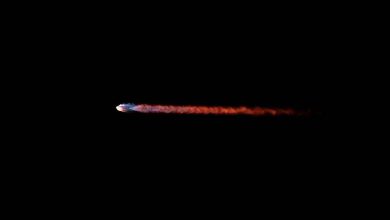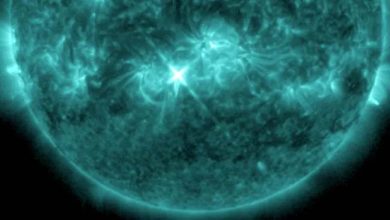X-class Halloween solar flare erupts from the Sun, causing radio blackout

Science: The sun put on a pretty scary show on Halloween, unleashing an X2.0 solar flare. A sunspot called AR 3878 unleashed an X-class flare measuring X2.0 on Oct. 31 at 5:20 p.m. EDT (2120 UTC). Sunspots are planet-sized dark areas on the sun where strong magnetic fields from within our star reach the surface.
According to Spaceweather.com, the solar flare did not produce a coronal mass ejection (CME), which eliminates the possibility of the geomagnetic storm impacting Earth and potentially creating aurorae, also known as the northern lights or aurora borealis. CMEs are made up of plumes of plasma and magnetic fields from the sun and can accompany solar flares, escaping from the explosion into space and reaching Earth. X-class flares are the most powerful type on the 4-level classification scale, being ten times more powerful than the next class, M-class. Each letter classification is followed by a number (2.0 in this case) indicating the relative strength of each flare.
The National Oceanic and Atmospheric Administration’s (NOAA) Space Weather Prediction Center (SWPC) reported that the flare was powerful enough to reach the R3-Strong level on its Space Weather Scale for Radio Blackouts, which focuses on what kind of effects a solar flare has on Earth. A shortwave radio blackout was reported following the explosion and impact signals across parts of the Pacific Ocean, along with the release of large amounts of ultraviolet (UV) radiation.
For many, the question remains: Will this flare bring an opportunity to see aurora in the coming days? As always, it all depends on whether or not the flare is accompanied by a CME and headed in our direction — which didn’t happen in this case.
This phenomenon causes auroras, mesmerizing light shows formed in the night sky when CMEs interact with Earth’s magnetic field, which funnels charged particles toward the poles. This is why we typically see auroras near the poles — the aurora borealis at the North Pole and the aurora australis at the South Pole. To determine whether a CME was released and is heading in Earth’s direction, scientists rely on images captured by a coronagraph on the National Aeronautics and Space Administration’s (NASA) and European Space Agency’s (ESA) Solar and Heliospheric Observatory (SOHO) spacecraft.





